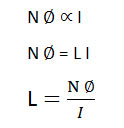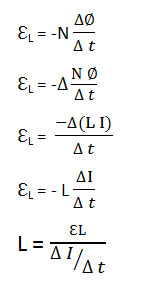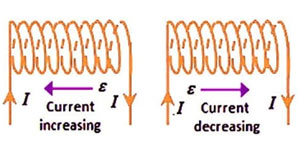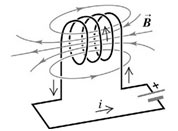Self-Induction
The phenomenon in which a changing current in a coil induces an EMF in itself is called self-induction.
The electromagnetic field can be envisaged as concentric loops of magnetic flux that border the wire, as well as larger ones that join up with others from other loops of the coil allowing self-coupling within the coil.
When current passes along a wire, and especially when it passes through a coil or inductor, a magnetic field is generated. This prolongs in an outward direction from the wire or inductor and can combine with various other circuits. Nonetheless, it additionally pairs with the circuit where it is set up.
Self-Inductance:
Self-inductance is the ratio of induced electromotive force (EMF) across a coil to the rate of change of current in the same coil.
When the current in the coil changes, this triggers a voltage to be induced in the different loops of the coil – the result of self-inductance.
Derivation of Self-Inductance
Let ![]() be the flux passing through one loop of the coil then the total flux for N number of turns will be N
be the flux passing through one loop of the coil then the total flux for N number of turns will be N ![]() . Since the flux (
. Since the flux (![]() = B.A) is proportional to the magnetic field which is B = µᵒ n I and the magnetic field is proportional to the current
= B.A) is proportional to the magnetic field which is B = µᵒ n I and the magnetic field is proportional to the current
So,

Where L is the constant of proportionality known as self-inductance.
According to Faraday’s law, emf can be expressed as

If the current in the coil is increasing, the self-induced emf produced in the coil will certainly oppose the cause of the current, which means the direction of the generated emf is contrary to the applied voltage.
If the current in the coil is decreasing, the emf generated in the coil remains in such a direction as to oppose the cause of the current; this implies that the direction of the self-induced emf is the same as that of the applied voltage.

Self-inductance does not prevent the change of current, however, it delays the change of current flowing through it.
Unit of Self-Inductance
The S I unit of self-inductance is Vs A -1 which is equal to Henry.
Henry
The self-inductance of the coil is said to be one henry if current changes at the rate of one ampere per second through it which causes an induced emf of one volt in the same coil.
Self-Induced Emf as Back Emf

The negative sign shows that the self-induced emf opposes the change which produces it. That is why self-induced emf is also called back emf.
This is according to Lenz’s law. If the current is increased, the self-induced emf tries to decrease the current, and similarly when the current is decreased the induce emf tries to increase the current.
MCQs
- What is self-induction?
- A. Induction of emf in a neighboring coil
- B. Induction of emf in the same coil
- C. Induction of emf in a resistor
- D. Induction of emf in a capacitor
- Answer: B
- Which phenomenon involves the generation of a magnetic field around a wire or inductor due to current flow, leading to self-coupling within the coil?
- A. Capacitance
- B. Self-induction
- C. Mutual induction
- D. Resistance
- Answer: B
- What does self-inductance represent?
- A. Ratio of induced EMF to the rate of change of current
- B. Ratio of current to voltage
- C. Ratio of voltage to current
- D. Ratio of magnetic flux to current
- Answer: A
- According to Faraday’s law, how is induced EMF expressed?
- A. E = L di/dt
- B. E = L ∫ di
- C. E = L ∫ dt
- D. E = L dt/di
- Answer: A
- What does the negative sign in the self-induced EMF equation indicate?
- A. It supports the change that produces it
- B. It opposes the change that produces it
- C. It amplifies the change that produces it
- D. It has no significance
- Answer: B
- What is the SI unit of self-inductance?
- A. Volt per Ampere
- B. Ampere per Volt
- C. Weber per Ampere
- D. Henry
- Answer: D
- When is the self-inductance of a coil said to be one henry?
- A. When the current changes at the rate of one volt per second
- B. When the current changes at the rate of one ampere per second
- C. When the voltage changes at the rate of one ampere per second
- D. When the flux changes at the rate of one ampere per second
- Answer: B
- What is another term for self-induced EMF?
- A. Forward EMF
- B. Leading EMF
- C. Back EMF
- D. Induced EMF
- Answer: C
- What law states that the self-induced EMF opposes the change that produces it?
- A. Coulomb’s law
- B. Ampere’s law
- C. Lenz’s law
- D. Faraday’s law
- Answer: C
- How does self-inductance affect the change of current in a coil?
- A. It prevents the change
- B. It accelerates the change
- C. It amplifies the change
- D. It delays the change
- Answer: D
- In the equation for self-inductance, what does ‘N’ represent?
- A. Total current
- B. Total flux
- C. Number of turns
- D. Magnetic field
- Answer: C
- What is the expression for self-induced EMF in terms of current variation?
- A. E = L dt/di
- B. E = L di/dt
- C. E = L ∫ di
- D. E = L ∫ dt
- Answer: B
- How is the total flux in a coil related to the flux per turn and the number of turns?
- A. Total flux = Flux per turn / Number of turns
- B. Total flux = Flux per turn * Number of turns
- C. Total flux = Number of turns / Flux per turn
- D. Total flux = Flux per turn + Number of turns
- Answer: B
- Which equation represents the variation of current with respect to time?
- A. ∫ di
- B. dt/di
- C. di/dt
- D. ∫ dt
- Answer: C
- What does the magnetic field generated by a current in a coil depend on?
- A. Resistance
- B. Voltage
- C. Current
- D. Capacitance
- Answer: C
- What is the constant of proportionality in the equation for self-inductance?
- A. Resistance
- B. Capacitance
- C. Inductance
- D. Conductance
- Answer: C
- In what direction does the self-induced EMF oppose the applied voltage when the current is increasing?
- A. Same direction
- B. Opposite direction
- C. No opposition
- D. Random direction
- Answer: B
- Which term refers to the loops of magnetic flux that border the wire and join up with others from other loops within a coil?
- A. Mutual induction
- B. Magnetic field
- C. Flux per turn
- D. Self-coupling
- Answer: D
- What happens to the self-induced EMF when the current in the coil is decreasing?
- A. It increases
- B. It remains constant
- C. It decreases
- D. It disappears
- Answer: A
Summary:
In this comprehensive tutorial on self-induction, self-inductance, and its unit, we delve into the fascinating realm of electromagnetism.
Understanding Self-Induction: Self-induction occurs when a changing current in a coil induces an electromotive force (emf) within the same coil. This phenomenon is facilitated by the generation of a magnetic field around the wire or inductor, forming concentric loops of magnetic flux that promote self-coupling within the coil.
Exploring Self-Inductance: Self-inductance, quantified as the ratio of induced emf across a coil to the rate of change of current in the coil, manifests itself as a fundamental property of electromagnetism. The change in current triggers the induction of voltage across different loops of the coil, underscoring the significance of self-inductance in electrical systems.
Derivation of Self-Inductance: Through an insightful derivation, we establish the relationship between flux, magnetic field, and self-inductance. By applying Faraday’s law, we discern how self-induced emf opposes the cause of the current, elucidating the role of self-inductance in modulating electrical phenomena.
Unit of Self-Inductance: The unit of self-inductance, denoted in henries (H), symbolizes the measure of a coil’s ability to resist changes in current flow. This unit, equivalent to volt-seconds per ampere, provides a standardized metric for assessing the self-inductive properties of electrical components.
Self-Induced Emf as Back Emf: Self-induced emf, often referred to as back emf, embodies Lenz’s law, where the negative sign signifies its opposition to the change that produces it. This phenomenon illustrates the intricate interplay between induced emf and current variation, elucidating the dynamic nature of electrical systems.
This tutorial offers a comprehensive understanding of self-induction, self-inductance, and their implications in electrical engineering, laying the groundwork for further exploration and application in diverse technological domains.

